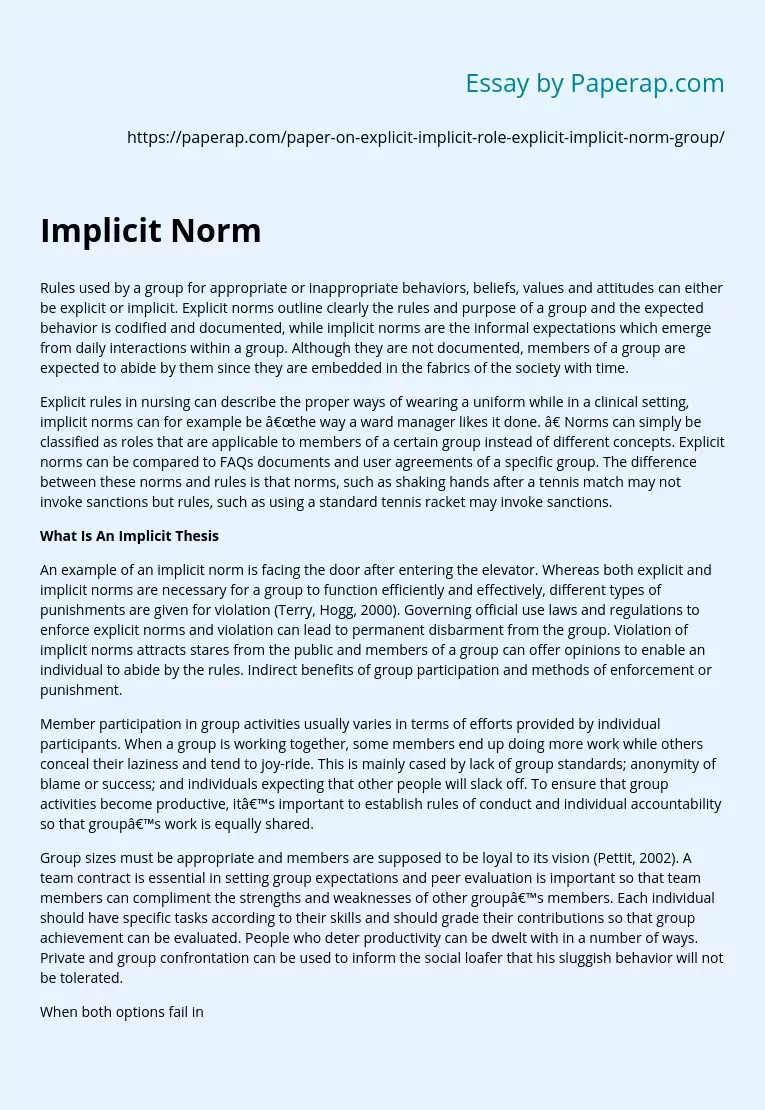Role of Explicit and Implicit Group Norms
Rules used by a group for appropriate or inappropriate behaviors, beliefs, values and attitudes can either be explicit or implicit. Explicit norms outline clearly the rules and purpose of a group and the expected behavior is codified and documented, while implicit norms are the informal expectations which emerge from daily interactions within a group. Although they are not documented, members of a group are expected to abide by them since they are embedded in the fabrics of the society with time.
Explicit rules in nursing can describe the proper ways of wearing a uniform while in a clinical setting, implicit norms can for example be “the way a ward manager likes it done. ” Norms can simply be classified as roles that are applicable to members of a certain group instead of different concepts. Explicit norms can be compared to FAQs documents and user agreements of a specific group. The difference between these norms and rules is that norms, such as shaking hands after a tennis match may not invoke sanctions but rules, such as using a standard tennis racket may invoke sanctions.
What Is An Implicit Norm
An example of an implicit norm is facing the door after entering the elevator. Whereas both explicit and implicit norms are necessary for a group to function efficiently and effectively, different types of punishments are given for violation (Terry, Hogg, 2000). Governing official use laws and regulations to enforce explicit norms and violation can lead to permanent disbarment from the group. Violation of implicit norms attracts stares from the public and members of a group can offer opinions to enable an individual to abide by the rules.
Indirect benefits of group participation and methods of enforcement or punishment.
Member participation in group activities usually varies in terms of efforts provided by individual participants. When a group is working together, some members end up doing more work while others conceal their laziness and tend to joy-ride. This is mainly cased by lack of group standards; anonymity of blame or success; and individuals expecting that other people will slack off. To ensure that group activities become productive, it’s important to establish rules of conduct and individual accountability so that group’s work is equally shared.
Group sizes must be appropriate and members are supposed to be loyal to its vision (Pettit, 2002). A team contract is essential in setting group expectations and peer evaluation is important so that team members can compliment the strengths and weaknesses of other group’s members. Each individual should have specific tasks according to their skills and should grade their contributions so that group achievement can be evaluated. People who deter productivity can be dwelt with in a number of ways. Private and group confrontation can be used to inform the social loafer that his sluggish behavior will not be tolerated.
When both options fail in changing the individual, the group leader can seek superior assistance either from an authoritative figure, a teacher or the boss. When possible, documented evidence should be provided concerning the laziness of the person (Dubois, 2002). Moreover, a last resort of trying to change a sluggish individual is exclusion from group activities. When the above options do not bare fruits, circumvention is the best option where the group can be reconstituted and each member given new responsibilities.
Role of Explicit and Implicit Group Norms. (2019, Dec 05). Retrieved from https://paperap.com/paper-on-explicit-implicit-role-explicit-implicit-norm-group/

